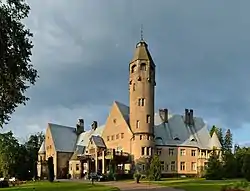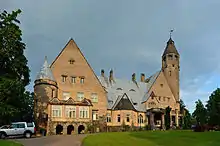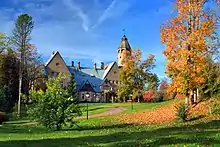Taagepera Castle
Taagepera Castle (German name: Wagenküll) is a mansion in Taagepera village, Helme Parish, Valga County, Estonia. It was registered as a national cultural monument on 27 September 1999.[1]


History
The first recorded mention of the mansion dates to the 16th century.
During the Polish rule and Swedish rule of Estonia, the mansion belonged to the Rehbinder family. In 1674, it was sold to the Swedish major Otto von Stackelberg.[2][3]
In 1819, the almost bankrupt mansion was sold to Bernhard Heinrich von Stryk (1746–1829), who married Anna Elisabeth von Oetting (1763–1825) in 1782. The last owner of the mansion was his great-grandson Hugo von Stryk, who lost the mansion in the 1919 land reform.
Mansion complex
Mansion house

The current mansion house was built in 1907 to an Art Nouveau design by the German architect Otto Wildau.[4][5][6] The western corner of the house includes a 40-metre tall tower. Because of the large size of the mansion house, it is commonly called a castle.
After the Estonian War of Independence in 1919, the mansion house was converted into a sanatorium. In the late 1930s, a new sanatorium building was added, designed by the architect Alar Kotli. The mansion house served as a sanatorium until 2000; since 2002 it has been a hotel. In mid-2018 it reopened after renovations as Castle Wagenküll Spa Hotel.[5]
Graveyard
In the late 19th century, a family graveyard was constructed near the mansion house. Among those buried there are:
- Katharina Mathilde von Stryk (née Rogge), born 15 July 1815 – died 13 April 1892
- Bernhard Heinrich Konstantin von Stryk, born 29 July 1827 – died 5 January 1912
Postage stamps
In 1933, Eesti Post designed a series of four stamps with an anti-tuberculosis theme, of which the blue/red 10-cent stamp and the dark blue/red 20-cent stamp depict the Taagepera mansion house (at that time a sanatorium). A new stamp depicting the Taagepera mansion house was issued in 2006.[7]
Gallery
 Exterior view
Exterior view Lobby
Lobby Lobby
Lobby Lobby
Lobby Stairway to second floor
Stairway to second floor Billiards room on the second floor
Billiards room on the second floor Jahisaal
Jahisaal Jahisaal
Jahisaal Jahisaal
Jahisaal Jahisaal
Jahisaal Jahisaal
Jahisaal Jahisaal - a chess board in the hall
Jahisaal - a chess board in the hall Anna Sophie restaurant
Anna Sophie restaurant Anna Sophie restaurant
Anna Sophie restaurant Anna Sophie restaurant
Anna Sophie restaurant Anna Sophie restaurant - castle cat
Anna Sophie restaurant - castle cat Hugo Saal
Hugo Saal Hugo Saal
Hugo Saal Rüütli Saal
Rüütli Saal Rüütli Saal
Rüütli Saal Stairway in the tower
Stairway in the tower Observation room in the tower
Observation room in the tower Stairway to top floor of tower from floor below
Stairway to top floor of tower from floor below Top floor of tower
Top floor of tower View from top floor of tower
View from top floor of tower View from top floor of tower
View from top floor of tower View from top floor of tower
View from top floor of tower View from top floor of tower
View from top floor of tower
References
- National registry entry (in Estonian).
- Genealogisches Handbuch der baltischen Ritterschaften, Estland, Teil 2.2, Görlitz 1930, pp. 292-
- Heinrich von Hagemeister, Materialien zu einer Geschichte der Landgüter Livlands T. 1–2, Riga 1836/1837, pp. 366–67
- Smurr, Robert; Wildau, Otto (1998). "Taagepera Manor". Retrieved 19 June 2017.
The Taagepera castle was built in 1907–1912 by Otto Wildau, a Baltic-German architect from Riga. With the numerous gables, balconies and solid chimneys of its forty-meter Western tower it resembles a medieval stronghold. Since 1920, Taagepera Manor has been used as a hospital
- Jarvis, Howard (6 July 2018). "Hotels: Estonia redevelops and rebrands a castle". Standby Nordic.
- Taylor, Neil (2014) [1995]. Estonia (7th ed.). Chalfont St Peter, Buckinghamshire: Bradt Travel Guides. p. 214. ISBN 978-1-84162-487-7.
- 2006 Estonian postage stamp depicting Taagepera Castle; archived from the original on 20 December 2013.